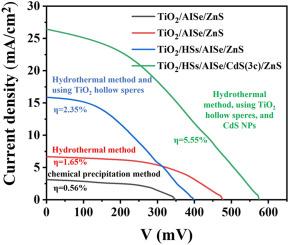AISe量子点合成方法和TiO2衬底厚度对量子点敏化太阳能电池性能的影响
IF 2.8
3区 物理与天体物理
Q2 PHYSICS, CONDENSED MATTER
引用次数: 0
摘要
本研究首次在90°C的化学沉淀法和谷胱甘肽盖层的水溶液中采用沉淀-水热联合方法合成了三元AgInSe2 (AISe)量子点。用化学沉淀法测试了三种银:银的比例(1:6,2:5,3:4),结果表明银含量的增加引起了吸收红移和带隙能量的降低。采用水热法制备的TiO2/AISe(1:6)/ZnS光阳极的PCE为0.56%,提高到1.72%。在450 mV开路电压下,优化TiO2的厚度和CdS的沉积循环次数可以提高光吸收、电荷分离和光电流密度(12 mA/cm2),效率为4.2%。将TiO2空心球作为散射层进一步提高了性能,实现了5.55%的最大PCE,比没有散射层的电池提高了46%。这些结果证明了优化后的基于aise的QDSSC结构用于高性能太阳能转换的有效性。本文章由计算机程序翻译,如有差异,请以英文原文为准。

Effect of AISe quantum dots synthesis method and TiO2 substrate thickness on the performance of quantum dots-sensitized solar cells
This study reports the first synthesis of ternary AgInSe2 (AISe) quantum dots using chemical precipitation at 90 °C and a combined precipitation–hydrothermal method in aqueous solution with glutathione capping. Three Ag:In ratios (1:6, 2:5, 3:4) were tested in the chemical precipitation method, showing that higher silver content caused a redshift in absorption and decreased bandgap energy. The TiO2/AISe(1:6)/ZnS photoanode achieved a PCE of 0.56 %, which increased to 1.72 % using the hydrothermal approach. Optimizing TiO2 thickness and the number of CdS deposition cycles enhanced light absorption, charge separation, and photocurrent density (12 mA/cm2) with an open-circuit voltage of 450 mV, yielding 4.2 % efficiency. Incorporating TiO2 hollow spheres as a scattering layer further improved performance, achieving a maximum PCE of 5.55 %, representing a 46 % increase over cells without scattering layers. These results demonstrate the effectiveness of the optimized AISe-based QDSSC structure for high-performance solar energy conversion.
求助全文
通过发布文献求助,成功后即可免费获取论文全文。
去求助
来源期刊

Physica B-condensed Matter
物理-物理:凝聚态物理
CiteScore
4.90
自引率
7.10%
发文量
703
审稿时长
44 days
期刊介绍:
Physica B: Condensed Matter comprises all condensed matter and material physics that involve theoretical, computational and experimental work.
Papers should contain further developments and a proper discussion on the physics of experimental or theoretical results in one of the following areas:
-Magnetism
-Materials physics
-Nanostructures and nanomaterials
-Optics and optical materials
-Quantum materials
-Semiconductors
-Strongly correlated systems
-Superconductivity
-Surfaces and interfaces
 求助内容:
求助内容: 应助结果提醒方式:
应助结果提醒方式:


